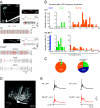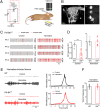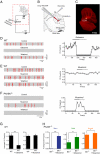Disruption of the olivo-cerebellar circuit by Purkinje neuron-specific ablation of BK channels
- PMID: 20566869
- PMCID: PMC2901450
- DOI: 10.1073/pnas.1001745107
Disruption of the olivo-cerebellar circuit by Purkinje neuron-specific ablation of BK channels
Abstract
The large-conductance voltage- and calcium-activated potassium (BK) channels are ubiquitously expressed in the brain and play an important role in the regulation of neuronal excitation. Previous work has shown that the total deletion of these channels causes an impaired motor behavior, consistent with a cerebellar dysfunction. Cellular analyses showed that a decrease in spike firing rate occurred in at least two types of cerebellar neurons, namely in Purkinje neurons (PNs) and in Golgi cells. To determine the relative role of PNs, we developed a cell-selective mouse mutant, which lacked functional BK channels exclusively in PNs. The behavioral analysis of these mice revealed clear symptoms of ataxia, indicating that the BK channels of PNs are of major importance for normal motor coordination. By using combined two-photon imaging and patch-clamp recordings in these mutant mice, we observed a unique type of synaptic dysfunction in vivo, namely a severe silencing of the climbing fiber-evoked complex spike activity. By performing targeted pharmacological manipulations combined with simultaneous patch-clamp recordings in PNs, we obtained direct evidence that this silencing of climbing fiber activity is due to a malfunction of the tripartite olivo-cerebellar feedback loop, consisting of the inhibitory synaptic connection of PNs to the deep cerebellar nuclei (DCN), followed by a projection of inhibitory DCN afferents to the inferior olive, the origin of climbing fibers. Taken together, our results establish an essential role of BK channels of PNs for both cerebellar motor coordination and feedback regulation in the olivo-cerebellar loop.
Conflict of interest statement
The authors declare no conflict of interest.
Figures




Similar articles
-
Purkinje cell BKchannel ablation induces abnormal rhythm in deep cerebellar nuclei and prevents LTD.Sci Rep. 2018 Mar 9;8(1):4220. doi: 10.1038/s41598-018-22654-6. Sci Rep. 2018. PMID: 29523816 Free PMC article.
-
BK Channel Regulation of Afterpotentials and Burst Firing in Cerebellar Purkinje Neurons.J Neurosci. 2021 Mar 31;41(13):2854-2869. doi: 10.1523/JNEUROSCI.0192-20.2021. Epub 2021 Feb 16. J Neurosci. 2021. PMID: 33593855 Free PMC article.
-
BK and Kv3.1 potassium channels control different aspects of deep cerebellar nuclear neurons action potentials and spiking activity.Cerebellum. 2011 Dec;10(4):647-58. doi: 10.1007/s12311-011-0279-9. Cerebellum. 2011. PMID: 21750937
-
Climbing fibers mediate vestibular modulation of both "complex" and "simple spikes" in Purkinje cells.Cerebellum. 2015 Oct;14(5):597-612. doi: 10.1007/s12311-015-0725-1. Cerebellum. 2015. PMID: 26424151 Review.
-
Population coding in the cerebellum: a machine learning perspective.J Neurophysiol. 2020 Dec 1;124(6):2022-2051. doi: 10.1152/jn.00449.2020. Epub 2020 Oct 28. J Neurophysiol. 2020. PMID: 33112717 Free PMC article. Review.
Cited by
-
Methamphetamine Regulation of Firing Activity of Dopamine Neurons.J Neurosci. 2016 Oct 5;36(40):10376-10391. doi: 10.1523/JNEUROSCI.1392-16.2016. J Neurosci. 2016. PMID: 27707972 Free PMC article.
-
Clusters of cerebellar Purkinje cells control their afferent climbing fiber discharge.Proc Natl Acad Sci U S A. 2013 Oct 1;110(40):16223-8. doi: 10.1073/pnas.1302310110. Epub 2013 Sep 17. Proc Natl Acad Sci U S A. 2013. PMID: 24046366 Free PMC article.
-
Dendritic potassium channel dysfunction may contribute to dendrite degeneration in spinocerebellar ataxia type 1.PLoS One. 2018 May 30;13(5):e0198040. doi: 10.1371/journal.pone.0198040. eCollection 2018. PLoS One. 2018. PMID: 29847609 Free PMC article.
-
Ion channel dysfunction in cerebellar ataxia.Neurosci Lett. 2019 Jan 1;688:41-48. doi: 10.1016/j.neulet.2018.02.005. Epub 2018 Feb 5. Neurosci Lett. 2019. PMID: 29421541 Free PMC article. Review.
-
Pathogenesis of severe ataxia and tremor without the typical signs of neurodegeneration.Neurobiol Dis. 2016 Feb;86:86-98. doi: 10.1016/j.nbd.2015.11.008. Epub 2015 Nov 14. Neurobiol Dis. 2016. PMID: 26586559 Free PMC article.
References
Publication types
MeSH terms
Substances
LinkOut - more resources
Full Text Sources
Other Literature Sources
Molecular Biology Databases
Miscellaneous

